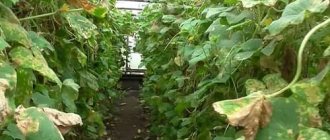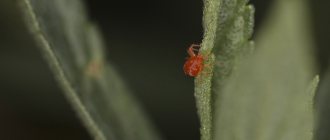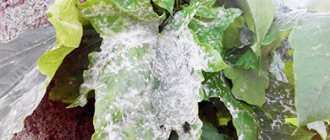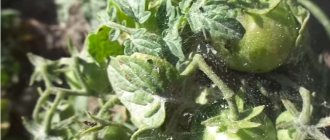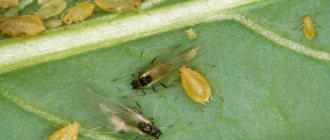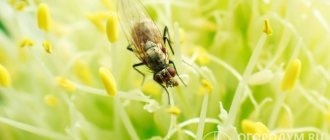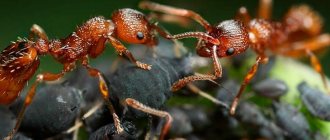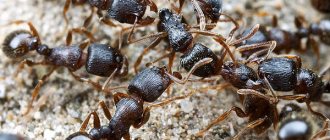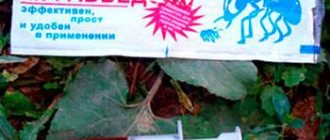Photos and symptoms of spider mites on raspberries
Spider mites are arachnid insects with a body length of no more than 0.7 mm. In nature, there are several types of pests, they differ in color. Most often, raspberries are affected by brown mites. But there are insects that are yellowish, green, and even milky in color. It is impossible to see microscopic insects on a plant, but an infestation of a bush can be determined by the following signs:
- a dense web that gradually covers the entire above-ground part;
- brownish or light spots on the underside of the leaves, gradually moving to the upper part;
- curling of young leaves;
- drying of buds.
Important! The appearance of signs of infection on the trunk indicates strong reproduction of the insect.
Description of the pest
The arthropod animal has microscopic dimensions. Females are up to 0.6 mm long. Males are even smaller. The color can be cream, brown with red, yellow with a greenish tint. These subtleties can only be seen through a microscope, so the gardener will not be able to see the enemy’s face, but he will be able to feel the consequences of his attack on the raspberries in all its glory.
The animal goes through several stages: egg, larva, caterpillar, nymph and only then an adult. Males are distinguished by dark spots on the body. The life activity of spider mites is possible in the temperature range of +20…32℃. During her life, the female manages to lay up to 200 eggs.
Females fertilized in late autumn can go to winter and enter diapause in order to continue the invasion of garden plants in the spring.
What harm does it do?
At the very beginning of infection, the mite does not pose a threat to the condition of the plant: the leaf on which the mites have settled dries out and falls. However, pests reproduce at high speed: one female produces up to 200 embryos in 30 days. The egg matures in just 3 days. In one growing season, only one parasite gives life to fifteen generations.
Adults and larvae feed on plant sap through punctures on the inside of the leaves. The multiplied population covers the entire above-ground part of the raspberry.
Mass infection causes enormous harm:
- shoots freeze and stop developing;
- the leaves first become marbled, then fall off;
- the buds do not open and the ovary does not form in them;
- the immunity and frost resistance of the plant decreases;
- Crop losses with severe infection amount to up to 70%.
It reproduces most quickly in hot, dry weather and especially in dense plantings.
For your information! Spider mites are carriers of a viral disease that is dangerous for raspberries - mosaic. The simultaneous impact of a pest and a disease can destroy all berry plantings in a short period of time.
What causes the appearance of an insect
The appearance of spider mites can be caused by several factors. This should be taken into account as a preventive measure for its occurrence. These reasons include:
- The air temperature remains above 20°C for a long time.
- Increased soil moisture and frequent heavy rains.
- Preservation of females in fallen leaves from the previous season.
- Weakened raspberry immunity due to lack of nutrients.
- Thickened bushes, insufficient oxygen.
- Infection from other plants.
How to fight with drugs?
The fight against the pest begins at the first signs of its appearance on the bushes, preventing its mass spread. There are several ways to solve the problem.
Chemicals
To reliably destroy pests at all stages of their development, only chemicals are used.
The tick does not belong to the class of insects, so specialized means are needed to combat it:
- Antio is a highly toxic drug that destroys pests at all stages of development after a single spraying.
- Fufanon is a broad-spectrum insectoacaricide. It disrupts the digestive system of pests and causes their death within 24 hours. The protective effect of the drug lasts 2 weeks.
- Akrex is a drug that combines fungicidal and acaricidal properties. The plants are sprayed with a solution of 0.8% concentration 2 times with an interval of 10 days. The product is highly toxic to humans, so protective agents are used during processing.
- Actellik is a non-systemic drug with enteric contact action. Once in the pest's body, the product disrupts the functioning of enzymes that carry out neuromuscular impulse transmission. Accumulating in the tissues of the victim, the drug blocks the functioning of all organs of the pest. The effect of the product begins 2-3 minutes after spraying. The activity of the product lasts 14-15 days.
- Anti-mite – the drug destroys adults and larvae within 2 hours after application. The action lasts 14-15 days. 10 ml of the product is diluted in 10 liters of water and 3 liters are used for 10 medium-sized bushes.
- Dimethoate is a highly toxic product that can be used no later than 40 days before harvesting the first berries. The drug has a systemic effect, accumulates in plant tissues, retains its properties for 25 days.
Carefully! Chemicals must not be used to treat plants during the formation and ripening of berries.
Biological agents
The use of biological products is an excellent alternative for opponents of chemistry. The following agents are most effective in combating spider mites on raspberries:
- Akarin – contains a neurotoxin isolated from the bacteria Streptomyces avermitilis. Paralyzes the nervous system of adult parasites. The drug is applied to the underside of the leaf 3 times with an interval of 10 days. This frequency is necessary to destroy insects hatched from eggs laid by females.
- Bitoxibacillin is a domestic drug produced since the 80s of the last century. It is especially effective to use the product during the larval stages of pest development. The drug is harmless to humans and animals. The bushes are treated with a solution of 1 mg per 10 liters of water 3 times every 3 days. Spray the inside of the leaf, where the pest mainly breeds.
- Fitoverm is a drug that destroys the digestive system of the pest. Treatment is carried out in cloudy weather with a solution of 10 ml per 8 liters of water. The protective effect of the drug lasts 30 days.
Varieties
In our country, the most common varieties are:
Common spider mite
Common spider mite (Tetranychus urticae). An insect of light or green color settles on garden crops, including tomatoes, cucumbers, basil, lettuce, currants, raspberries, gooseberries, strawberries, and sweet peppers. Does not disdain indoor roses, tradescantia, geranium, asparagus and any other available flowers.
Red spider mite
Red spider mite (Tetranychus cinnabarinus). The small insect most often ends up in apartments with exotic plants or soil. Found on orchids, indoor and outdoor roses, citrus trees, and palm trees.
In the photo there is a common and red spider mite
Atlantic spider mite
Atlantic spider mite (Tetranychus atlanticus). Unlike its counterparts, the pest prefers conditions of high humidity. As a rule, such a tick feeds on palm trees, citrus and fruit trees, melons, and ornamental conifers. It can be found on cypresses, thujas, and junipers.
Cyclamen spider mite
Cyclamen spider mite (Phytonemus pallidus). The pest prefers to settle in soils. It feeds on bulbous garden plants and flowers - lilies, tulips, petunias, daisies, azaleas, dahlias and others. At home, it often affects violets, cyclamens, chrysanthemums, geraniums, fuchsias, and begonias. The smallest pest. The colony looks like a coating of gray dust.
In the photo there is an Atlantic spider mite and a cyclamen
Fighting cobwebs on raspberries using folk methods
Insect repellents prepared according to folk recipes are not capable of destroying pests. Their effect is mainly repellent, so the bushes are sprayed for preventive purposes.
The following means are used against the pest:
- Onion infusion. 20 g of onions are added to 1 liter of water and left for 7 hours. Then filter and spray the bushes.
- Dandelion infusion. 20 g of roots are infused in 1 liter of warm water for 2 hours.
- Garlic infusion. Take 150 g of garlic pulp per 1 liter of water and leave for 5 days in a dark place. Before use, 5 ml of infusion is diluted in 1 liter of water.
- Infusion of tobacco. Crushed young leaves in the amount of 45 g are poured into 1 liter of water and the bushes are sprayed every other day for a week.
- Mustard solution. 1 package of dry powder is dissolved in 5 liters. water, spray the bush.
- Horseradish decoction. 1 kg of roots is crushed, poured with a bucket of water and boiled. The resulting broth is infused for 2 days, filtered. The resulting product is sprayed on raspberries every 10 days. The decoction is stored in a cool place.
- Vinegar. 1 l. table vinegar is diluted in 5 liters. water and spray.
Signs of parasitism
Symptoms of damage to red and black currants depend on the species of parasites. Plants face attacks from spider mites and bud mites.
Kidney mite
The pest can be identified by the appearance of the buds. They enlarge and become deformed. The round buds then develop into irregularly shaped leaves. The bud mite causes the leaves to lose color and acquire a rough texture.
After some time, the affected currant shoots stop developing. Insects quickly spread throughout the plant. If measures are not taken in time, there is a risk of crop death.
Cobweb
Spider mites are easy to identify. The key symptom is the formation of a thin web, which is localized on the leaves, between the shoots, and on the berries. Pests feed on the juices of currant leaves. As a result, the affected fragments lose their shape and become covered with spots. The processes of decay begin in them.
Description of the Belarusian sweet blackcurrant variety, planting and care rules
Read
Terms and rules for spraying bushes
To achieve maximum effect, pest control on raspberries is carried out comprehensively, using several means simultaneously. As a preventive measure, even before the leaves bloom, the bushes are sprayed with a urea solution at a concentration of 6%. If preventive spraying does not produce results, chemical and biological products are used.
The first treatment is carried out before the female lays eggs. All damaged parts of the plant are removed from the bush and burned. The soil under the bushes is dug up to a shallow depth so as not to damage the roots. When spraying a bush with chemicals, the surface of the soil must also be treated.
After preparatory measures, a comprehensive fight against insects begins. Practice shows that three-time treatment of bushes according to the following scheme is most effective:
- a chemical to kill adults;
- re-treatment after 10 days with a chemical to destroy a new colony of pests hatched from eggs;
- after 10-14 days, preventive treatment with a biological product to protect the plantings from re-infection.
Folk remedies can be used at any time, since they are non-toxic and do not accumulate in fruits. After destroying the pests, until the end of the growing season, you can periodically spray the bushes with a product prepared according to one of the folk recipes. This will help avoid re-infection of raspberries with spider mites.
Prevention
Fighting a tick is more difficult than following the rules of prevention, which are quite simple:
- do not thicken the raspberry bushes, tie them to trellises to ensure good air exchange;
- do not plant raspberries on the site of old plantations;
- regularly carry out sanitary pruning, mercilessly remove damaged, dry shoots and burn them;
- get rid of weeds in the raspberry field in a timely manner;
- loosen the soil more often, and do shallow digging in late autumn and spring to prevent the arthropod from overwintering successfully.
If you water raspberries on time, the likelihood of being attacked by spider mites will decrease, since the pest does not like moisture.
Raspberry beetle
These 4mm grayish bugs feed on buds in May. In addition, females prefer to lay eggs in flowers and raspberry ovaries. As a result, many berries turn out to be wormy.
How to solve a problem? During the budding period, insects are shaken off onto film and destroyed. It is useful to cover the buds with some non-woven material. Many experienced summer residents and gardeners treat buds with 10% karbofos.
Beetles cannot tolerate tansy infusion. It is prepared simply: dry shoots (350 g) + water (5 l). Infuses for two days. Used after boiling for 30 minutes, straining and diluting with five liters of water. It is more effective to spray in the evening.
Preventive measures
The main preventive measure to combat cobwebs is to keep the raspberry plant clean. Plant debris becomes a refuge for overwintering pests, so in the fall all old or infected shoots are cut out and burned.
Additionally, you should follow the following recommendations from experienced gardeners:
- prevent excessive planting density and bush growth;
- feed plants in a timely manner to increase their immunity;
- regularly remove weeds under bushes and within a radius of at least a meter;
- avoid overmoistening and overdrying of the soil;
- cut old bushes at the roots in the fall;
- treatment of bushes with Karbofos solution (55 ml per 1 liter) in preparation for winter;
- mulch the soil surface under the bushes.
Advice! Some gardeners recommend planting plants that have a repellent effect next to the raspberry tree: lavender, marigolds, basil, garlic.
Spider mites are a frequent visitor to raspberry bushes, so gardeners should carefully inspect the plantings and begin combating the pest in a timely manner. Its excessive reproduction will lead to a significant reduction in yield and can completely destroy the plants.
Feedback from agronomists
Stonikov K.P., 44 years old, Sevastopol If you plant plants that repel ticks in the area near the raspberries, and the remaining crops are located far enough away, provided that preparations are made before the start of the season, there is every chance of avoiding a collision with parasites.
Makeev O.S., 49 years old, Pskov I am not against acaricides on the plot, but they have a very aggressive effect on raspberries, so it is better to limit yourself to treating the bushes in spring and autumn (with the required frequency). If there have already been precedents for removing mites, it is better to carefully monitor the plants during the warm season. It is much easier to immediately eliminate lesions than to remove an entire colony later.
Malyshev L.I., 38 years old, Bryansk Sometimes you have to destroy ticks several times a season. If you do this with one drug, pests may develop resistance. It is better to use a new type of product each time. This is not always possible, so I recommend at least alternating 2 drugs. Then the struggle will bring better results. If you use one type of product, then even following all the recommendations will not help remove parasites.
Young shoots are more at risk
